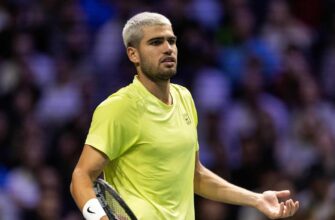The world of professional tennis often presents a spectacle of incredible athleticism and unwavering mental fortitude. Yet, beneath the surface of powerful serves and grueling rallies, lie the very human vulnerabilities of its stars. The recent withdrawal of Jannik Sinner from the Cincinnati Masters final against Carlos Alcaraz serves as a potent reminder of these underlying pressures, shedding light on the silent battles players fight off-court.
A Champion`s Visible Distress
On what should have been a marquee clash, Jannik Sinner appeared on court not as the usual picture of competitive vigor, but as a visibly diminished figure. His pallid complexion, sluggish movements, and a clear lack of customary reactivity spoke volumes, even before the match officially began. Within just 23 minutes, trailing 5-0 in the first set, the Italian talent made the difficult decision to retire, reportedly murmuring to ATP medical staff, “I`m too sick, I can`t move.”
In the post-match remarks, Sinner remained understandably brief on specifics, stating only, “I was feeling bad since yesterday, hoped to improve overnight, but conditions worsened.” His words, while concise, offered a glimpse into the hidden struggle that often precedes such abrupt departures from elite competition.
The Elusive Adversary: Virus or Vapors?
Initial speculation quickly ruled out any overt mechanical injury or the rather dramatic notion of food poisoning. The prevailing hypothesis among observers and reports leaned heavily towards a viral infection. Sinner’s profound lack of energy and vitality on court was consistent with someone battling an unwelcome internal guest. Indeed, the Cincinnati tournament had seen a notable string of illnesses and withdrawals among players, suggesting a potential contagion within the competitive bubble in Ohio.
However, the narrative is not solely about an invisible microbe. Cincinnati`s environmental conditions played a formidable supporting role. Sinner himself commented during the trophy ceremony, “It was one of the hottest tournaments we`ve played, maybe the hottest ever.” This oppressive heat, coupled with the stark temperature fluctuations between the air-conditioned player lounges and the humid outdoor courts, likely created a perfect storm for athlete vulnerability. Imagine going from an arctic blast to a tropical sauna multiple times a day—a recipe for physical shock, even for the most conditioned bodies. The extended 12-day format of the upgraded tournament also meant prolonged exposure to these taxing conditions, perhaps pushing some athletes beyond their limits.
The Grueling Grind of the ATP Tour
Sinner’s withdrawal, while specific to his situation, underscores a broader, often overlooked aspect of professional tennis: the immense physical and mental toll exacted by a relentless global schedule. Players travel across continents, adapting to different time zones, climates, and surfaces, all while striving for peak performance week after week. It`s a demanding dance, and sometimes, the music simply stops.
In a world where athletes are expected to be unwavering bastions of health and resilience, moments like Sinner`s retirement serve as a sobering, if inconvenient, reminder that they are, in fact, human beings, susceptible to the same common ailments that plague the rest of us. The difference, of course, is that their “sick days” are televised and dissected globally, adding another layer of pressure to an already challenging recovery process.
Looking Ahead: Recovery and the Next Serve
With Cincinnati now in the rearview mirror, Sinner has reportedly traveled to New York, prioritizing absolute rest and recovery. Further medical examinations will undoubtedly provide clearer answers, but for now, the immediate focus is on regaining full health ahead of upcoming critical events. His swift withdrawal from the scheduled mixed doubles event signals a clear commitment to prioritizing his well-being.
The incident at Cincinnati is more than just a footnote in a tournament`s history; it`s a testament to the fragile balance between human endurance and the uncompromising demands of elite sport. It prompts a quiet reflection on the unseen struggles behind the spotlight, reminding us that even the most formidable champions occasionally need to step back to fight another day.






